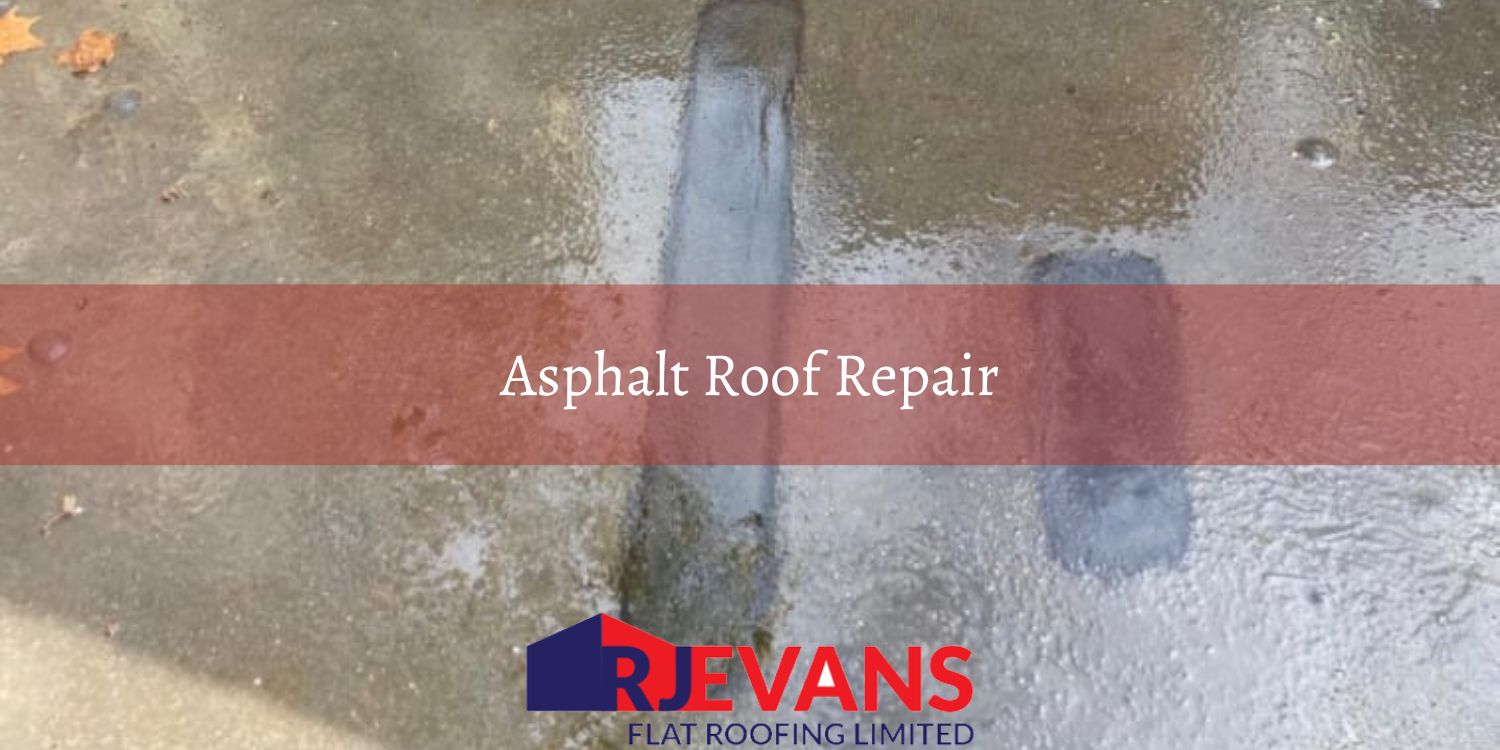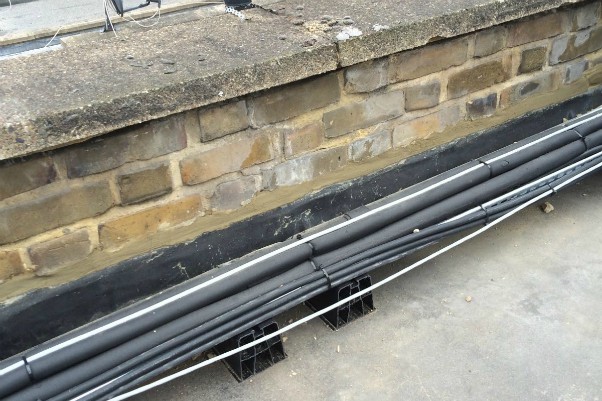I agree Our site saves small pieces of text information (cookies) on your device in order to deliver better content and for statistical purposes. You can disable the usage of cookies by changing the settings of your browser. By browsing our website without changing the browser settings you grant us permission to store that information on your device.

Mastic asphalt roof repair involves the process of restoring and maintaining the integrity of a mastic asphalt roofing system to ensure its continued waterproofing performance and extend its service life. This type of repair can include patching holes, sealing cracks, and smoothing out surface imperfections, as well as rejuvenating aged or weathered asphalt to restore its original protective qualities. The objective is to address any damage promptly and effectively to prevent leaks and further degradation, preserving the roof's seamless, impermeable barrier against moisture ingress.
At RJ Evans, we offer expert asphalt roof repair services, ensuring your roof remains in top condition and protected from the elements. For more information or a quote, please contact us via our contact form or call us now on 01277 375 511. One of our friendly team members will be delighted to assist you.

Mastic asphalt roof repair is a specialised procedure aimed at rectifying defects and damages in a mastic asphalt roofing system to restore its waterproofing efficiency and structural integrity. Over time, factors such as weather exposure, thermal movement, and mechanical damage can compromise the seamless surface of mastic asphalt roofs, leading to issues like cracks, blistering, and water ingress. Repair work typically involves cleaning the affected area, removing any loose or damaged material, and then applying fresh mastic asphalt to fill gaps and re-establish the continuous, impermeable membrane that characterizes these roofs. In more severe cases, it may also include reinforcing weakened areas with fabric mesh before applying the new asphalt layer.
The process not only prevents leaks and extends the roof's lifespan but also maintains the aesthetic appearance of the roof surface. Additionally, since mastic asphalt is known for its flexibility and durability, repairs can often be conducted with minimal disruption and without the need for a complete roof overhaul. The goal of mastic asphalt roof repair is to swiftly and efficiently address any deterioration, ensuring the roof continues to offer superior protection against the elements while upholding the building’s overall structural health. This type of repair underscores the value of mastic asphalt roofing as a long-term, reliable roofing solution.
The main signs an asphalt roof repair is required are one or more of the following; leakage, pooling water, cracks and blistering, slumping or slagging or surface wear. Recognising the signs that an asphalt roof may require repairs is crucial for maintaining the integrity and longevity of your roofing system. Certain indicators are more telling than others when it comes to the likelihood of needing immediate repair work. From the unmistakable evidence of water leakage to more subtle signs like discolouration or moss growth, each symptom reflects different levels of urgency and potential damage to the roof's structure.
Leakage is a clear and undeniable sign that water has breached the roof's defences, manifesting through visible drips, damp spots on ceilings, or water stains on interior walls. This immediate evidence of water penetration demands prompt repair actions to prevent structural damage, mould growth, and deterioration of interior finishes. The presence of leaks often necessitates a thorough inspection to identify and rectify the source of water entry, ensuring the integrity of the roof is restored.
Pooling or standing water on a roof surface points to inadequate drainage, which can be caused by improper roof design, clogged drains, or settlement of the roof structure. If not addressed, pooled water significantly increases the risk of leakage and structural damage, as it exerts extra weight and pressure on the roofing system. Ensuring proper drainage through maintenance or structural adjustments is vital to prevent the escalation of water-related damages.
Visible cracks and blistering on the asphalt surface indicate that the material has lost its elasticity and integrity, making it vulnerable to water ingress. These defects often result from aging, thermal cycling, or mechanical impacts. Repairing or replacing the affected sections of the roof is essential to reinstating its waterproof barrier and preventing further deterioration.
Slumping or sagging areas on a roof suggest underlying structural issues, such as inadequate support, water damage to the roof deck, or failure of roofing material under load. This condition compromises the roof's ability to shed water effectively, creating potential for water pooling and ingress. Addressing structural deficiencies and reinforcing the roof's support system are critical steps in correcting slumping or sagging.
Significant wear of the roof's surface, including the loss of mineral granules and thinning of the asphalt layer, exposes the roof to the elements. This deterioration reduces the roof's ability to repel water and resist UV light, making it more prone to leaks and further damage. Regular maintenance is crucial to identify and address areas of wear before they evolve into more severe problems.
Flashing around roof protrusions, such as vents, chimneys, and edges, serves as a critical barrier against water entry. When flashing becomes loose or damaged, it creates vulnerabilities in the roof's waterproofing system. Repairing or replacing compromised flashing is essential to prevent water from entering at these junctions, which are among the most common sites for leaks.
The presence of moss and algae on a roof is not merely an aesthetic issue; it signifies prolonged moisture presence on the roof surface. These organisms can retain moisture against the roof, causing the roofing materials to break down over time and leading to potential leaks. Removing vegetation and addressing the moisture issue is vital to prevent further damage.
Discolouration or staining of the roof surface may signal water damage, algae growth, or the breakdown of roofing materials due to UV exposure. Such changes in appearance can indicate areas where moisture has penetrated or is being retained, necessitating a closer inspection to determine if repairs are needed to restore the roof's protective qualities.
To repair an asphalt roof the ‘hot poultice’ method is normally used. The 'hot poultice method' is where heat will be applied to the perimeter causing the asphalt to soften. This allows us to cut into the perimeter with a hammer and bolster. Next, we carefully lift the asphalt which has been cut out with a shovel or pick.
Now we must repair the affected area where the asphalt has been removed. The exposed perimeter is cleaned up to create a break joint. This break joint is created 10mm beneath the top surface edge. Next, we cut a piece of sheathing felt to the size of the exposed area and place it inside.
The next step is to apply our first layer of mastic asphalt which one of our operatives would have prepared by melting mastic asphalt blocks in our mixer. This coat is 10mm and spread in a smooth even coat with a wooden float. This will be finished with 10mm edge joints which are reheated by the asphalt and then remade.
Once this has been done we wait for the asphalt to cool down. Depending on the specification or the situation a second coat of mastic asphalt may be necessary.
Then a top coat will be laid with all the joints remade. The result will be an even plane with edges showing a ‘fusion’ joint between the old asphalt and the newly applied asphalt.
Then we scatter coarse sand evenly across the area. The reason for this is for the sand to absorb the bitumen in the asphalt. If this is not done when it rains the water will pool and within a matter of weeks all the bitumen will be drawn out of the asphalt and it will become a faded grey colour. Also, crazing will occur which is when the asphalt surface has the appearance of continuous cracking throughout.
Within 20 to 40 minutes the asphalt will be cooled off and the asphalt flat roof repair will be completed. The last step which is recommended is to apply a coat of solar reflective paint over the new repair (and frequently the entire roof). The reason for this is to maximise the asphalts life and minimise the movement which occurs through the season due to period of intense UV rays which cause the roof to expand and colder conditions which cause the roof to contract. Over time this cycle causes the typical reasons for asphalt roof repair work being needed.
Once all this has been done the roof is ready for foot traffic and to undertake the everyday duties required of it.
If you are in a dilemma as to whether you should repair or replace your flat roof the blog Should I Repair Or Replace My Asphalt Roof is likely to be perfect for you.
Asphalt is an amazing roofing material as if it does ever suffer from any damage it can easily be repaired. This make an asphalt roofing system very hard to compete with when it comes to longevity. An asphalt roof which is maintained every 3 to 5 years will survive way past any guarantees which have been issued for the roofing system.
Normally when it comes to asphalt roof repairs all that is needed is a few small repairs and a new coating of solar reflective paint.
An experience asphalt spreader will easily find and rectify any necessary repair work. The seamless smooth finish of an asphalt roof ensures any problems are immediately visible and dealt with without fuss.
In situations where an asphalt roof is coming to the end of its lifespan an experienced asphalter would immediately recognise this and offer advice on the most cost effective remedy to the situation.
• We have our own Asphalt Mixer this means a flame free laying of the mastic asphalt. Better consistency in the asphalt mixture meaning a more efficient installation process with a better overall finish.
• Vastly experienced asphalt team. We have operatives with more than 40 years’ experience.
• We provide a range of FREE quotations and solutions for all projects.
• Insurance backed Guarantees.
• Excellent Customer Support throughout project.
• Rated 5 out of 5 from our previous customers.
If you would like a quotation or any information on asphalt roof repairs please get in touch with us or call us now on 01277 375 511. One of our friendly team of asphalt specialists will be happy to help.
.